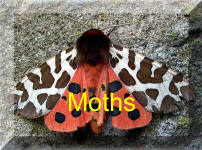ABH 68.001
Emperor Moth Saturnia pavonia
BF 1643
Back To
(Linnaeus, 1758)
Phenology
JAN
FEB
MAR
APR
MAY
JUN
JUL
AUG
SEP
OCT
NOV
DEC
Family
Saturniidae
Wingspan
c 40-60 mm.
Description
Males are reddish
grey with two white patches on the forewings which contain prominent
eye spots. There is a suffused white band at the termen of each
forewing and a red apical streak. The dark eye spots on the tawny-coloured
hindwings are concealed when the moth is at rest but shown when
the moth is alarmed or threatened. There is a diffused blackish
band towards the outer margins of the hindwings. The females are
larger than males and mainly grey on both wings and has similar
markings
Life Cycle
This moth flies by
day and the males can be seen skipping over the moorlans at speed
in search of females that shelter within the heather in May and June.
Mature caterpillars of the emperor moth is lime green with yellow
or orange warts, which sprout black bristles!The bright green larvae
have been recorded on meadowsweet and heather. The full-grown larvae
spin a tough silken cocoon attached to the stems of heather and other
low-growing herbage. The pupa overwinters. Like many cocoon spinning
species, they are often predated on by small mammals during the winter
months.Males are active in sunshine and are seen flying swiftly and
erratically over heather in search of newly emerged females. These
stay concealed low down in the vegetation where they can occasionally
be seen during the day. Females, which are nocturnal, are also attracted
to light in small numbers. Mid-April
to late June..The
fully grown caterpillar is green with black hoops containing yellow
wart-like spots, and feeds on moorland plants such as heather (Calluna)
and bramble (Rubus).
Habitat
Emperor Moths are
spectacular moths associated with heaths, bogs and moorland. , it
has large eye markings which scare off predators.
Links
Images
By jean-pierre Hamon (Own work)
[GFDL, CC-BY-SA-3.0
or CC
BY-SA 2.5-2.0-1.0], via
Wikimedia Commons
ABH 68.001 |
Emperor Moth Saturnia pavonia |
BF 1643 |
|||||||||||||
|
|
|||||||||||||||
| Back To | (Linnaeus, 1758) |
||||||||||||||
|
|||||||||||||||
Phenology |
|
||||||||||||||
Family |
Saturniidae | ||||||||||||||
Wingspan |
c 40-60 mm. | ||||||||||||||
Description |
Males are reddish grey with two white patches on the forewings which contain prominent eye spots. There is a suffused white band at the termen of each forewing and a red apical streak. The dark eye spots on the tawny-coloured hindwings are concealed when the moth is at rest but shown when the moth is alarmed or threatened. There is a diffused blackish band towards the outer margins of the hindwings. The females are larger than males and mainly grey on both wings and has similar markings |
||||||||||||||
Life Cycle |
This moth flies by day and the males can be seen skipping over the moorlans at speed in search of females that shelter within the heather in May and June. Mature caterpillars of the emperor moth is lime green with yellow or orange warts, which sprout black bristles!The bright green larvae have been recorded on meadowsweet and heather. The full-grown larvae spin a tough silken cocoon attached to the stems of heather and other low-growing herbage. The pupa overwinters. Like many cocoon spinning species, they are often predated on by small mammals during the winter months.Males are active in sunshine and are seen flying swiftly and erratically over heather in search of newly emerged females. These stay concealed low down in the vegetation where they can occasionally be seen during the day. Females, which are nocturnal, are also attracted to light in small numbers. Mid-April to late June..The fully grown caterpillar is green with black hoops containing yellow wart-like spots, and feeds on moorland plants such as heather (Calluna) and bramble (Rubus). | ||||||||||||||
Habitat |
Emperor Moths are spectacular moths associated with heaths, bogs and moorland. , it has large eye markings which scare off predators. | ||||||||||||||
Links |
|
||||||||||||||
Images |
By jean-pierre Hamon (Own work) [GFDL, CC-BY-SA-3.0 or CC BY-SA 2.5-2.0-1.0], via Wikimedia Commons |
||||||||||||||
|
|
|||||||||||||||


